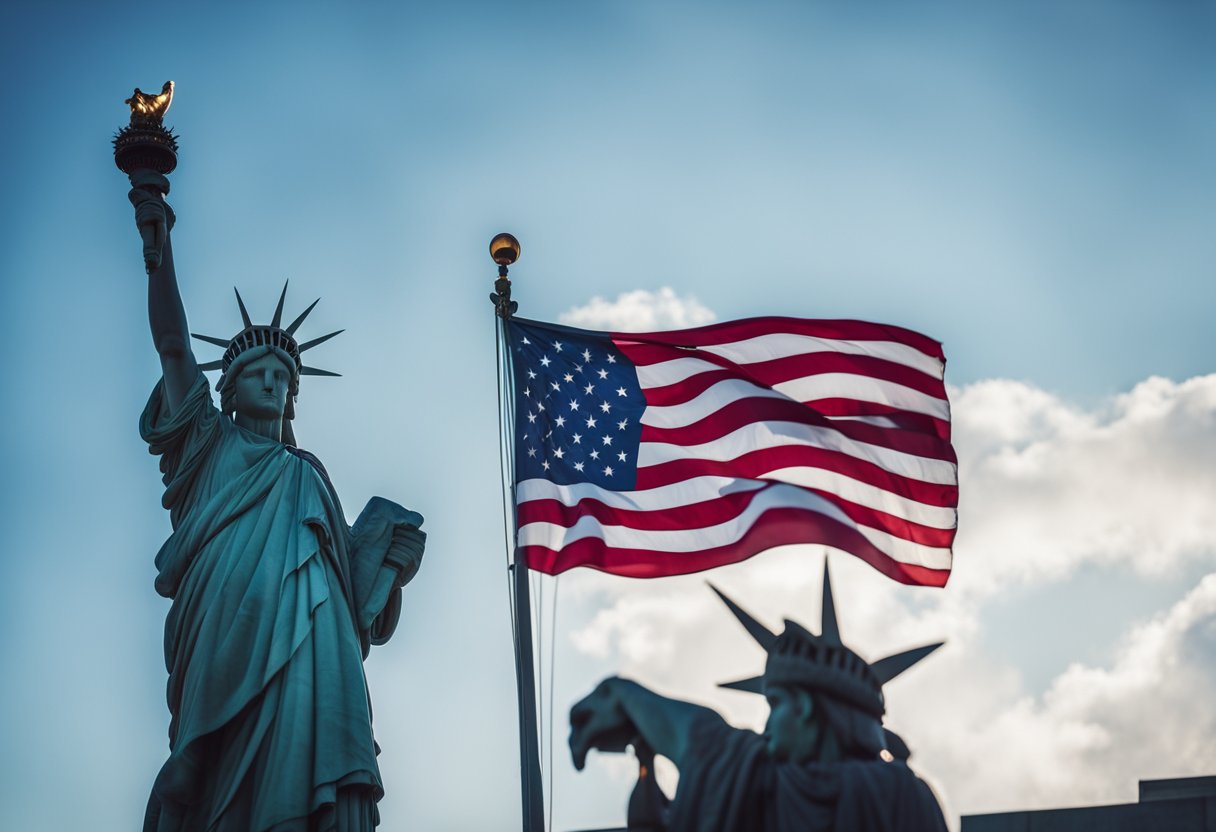The United States of America has long been a subject of discussion when it comes to its standing in the world. Across generations and party lines, Americans have expressed varying degrees of pride and criticism regarding their nation’s global position. Historical trends show that views on whether the U.S. is the greatest country have fluctuated over time, with factors such as age and political affiliation influencing opinions.

Despite diverse perspectives, many point to the United States’ contributions in various fields as evidence of its preeminence. Innovations in technology, strong cultural influence through media and entertainment, and a history of leadership in international affairs are frequently cited. The country’s size, economic power, and resources also play significant roles in shaping the perception that America is a leading nation.
Furthermore, international surveys often reflect a recognition of the U.S. as a top contender on the global stage. The perceptions of America’s status are informed not only by its achievements but also by the values it projects, such as democracy and freedom. These ideals continue to attract attention and shape the dialogue around America’s place in the world.
Let’s talk about why America is the greatest country in the world.
Foundations of Greatness

America, often referred to as the United States, is widely recognized for its strong democratic roots and historically significant development. These two subsections delve into the core aspects that have shaped its reputation as a leading nation.
Basis of Democracy
The United States was founded on principles of democracy that are enshrined in its Constitution. It established a system where power is derived from the people, with an emphasis on freedom and individual rights. This democratic foundation ensures that governance is by the people and for the people, with mechanisms like free elections and the separation of powers to prevent autocracy.
Historical Significance
The American history is marked by pivotal events that reflect its growth and the resilience of its people. From the Declaration of Independence in 1776 to the expansion of civil rights throughout its history, the United States has navigated internal and external challenges while striving to uphold its foundational values of liberty and justice. These events not only shape the narrative of the great nation but also resonate globally, influencing societies and governments beyond its borders.
Cultural Influence and Innovation
America’s cultural dominance is aptly reflected in its widespread impact on art and entertainment as well as its substantial technological contributions that have shaped the modern world.
Impact on Art and Entertainment
American art and entertainment have had a significant impact on global culture. With origins in varied forms, America has consistently contributed to the evolution of these realms on an international scale. From pop art icons such as Andy Warhol, who brought everyday commercial and popular culture into the art galleries, to Hollywood films that command vast audiences worldwide, America has been pivotal in shaping the planet’s tastes and sensibilities. Television shows, music genres such as jazz and hip-hop, and literature are further areas where America’s cultural influence is unmistakable.
Technological Advances
In the realm of science and technology, America has been a bedrock of innovation. The advent of the Internet, a transformative global network which has fundamentally altered communication and commerce, had much of its development through American ingenuity. Pioneering companies like Apple have revolutionized the way people interact with technology, through personal computing and smartphones. America’s investment in science continues to lead to significant advancements in various fields, from medicine to renewable energy, influencing the world’s progress towards a more connected and sustainable future.
Economic Powerhouse
The United States holds a defining position on the global stage as an economic leader. Its market influence and technological innovations continue to shape the international economic landscape. When talking about why America is the greatest country in the world, the economy plays a huge role.
Global Market Leadership
The United States operates the largest and one of the most influential stock exchanges in the world, the New York Stock Exchange. This market is a barometer for the global economy, and American companies listed here are often industry leaders across various sectors. Additionally, the U.S. GDP is marked by robust growth rates that consistently outpace those of other developed nations, signaling the country’s unwavering economic strength.
- GDP Growth: The U.S. GDP is expected to grow more than double the rate of the UK’s economy
- Market Dominance: American corporations like Apple assert significant influence on global commerce
Advancements in Science and Technology
America is home to some of the world’s most innovative companies and research institutions. They are at the forefront of advancements in various fields, including but not limited to computing, medicine, and engineering.
- Innovation Leaders: Companies such as Apple spearhead advancements in technology, influencing consumer electronics globally
- Research and Development: The U.S. consistently invests in scientific research, driving progress and fostering innovation
American economic power is reinforced by its blend of market leadership and continuous technological advancements, ensuring its role as a dominant global force.
Diversity and Opportunity

America’s landscape is distinguished by a vibrant tapestry of ethnic diversity and a bedrock of opportunities that drive progress in various fields.
Melting Pot of Ethnicities
America is known as a melting pot, where a multitude of ethnicities and races coalesce to form a diverse cultural landscape. Census data reveals that the country is home to people from virtually every nation on Earth, contributing to a rich mosaic of cultural practices, languages, and traditions.
- Ethnic Composition: Among the population, a significant number of Americans identify as:
- Caucasian
- African American
- Hispanic or Latino
- Asian
- Native American
- and others, including individuals of mixed race.
This diversity is not only a source of cultural wealth but also fosters a dynamic and innovative society.
Education and Progress
In terms of education, America has historically been a pioneer, with its robust education system offering opportunities for all, regardless of race or ethnicity. Educational institutions often serve as hubs for social mobility and progress.
Educational Institutions: Notable for their diversity, American schools and universities are microcosms of society where students of different backgrounds learn from one another.
Progress Through Education: Advancements in science, technology, and the arts are frequently a direct result of the diverse perspectives found within American educational settings.
Education is a key area in which America shines, propelling individuals from varied racial and ethnic backgrounds to success and thereby contributing to the greatest nation’s position as a leader in innovation and social progress.
Political Landscape
The United States’ political landscape is characterized by its longstanding tradition of democracy and a robust two-party system, involving Democrats and Republicans, each contributing to the nation’s governance through varying ideologies.
Democratic Ideals
In America, democratic ideals are the bedrock of its political system. These ideals advocate for freedoms such as speech, religion, and press, alongside a commitment to human rights and equal justice. They uphold the principle that government should be elected by the people, for the people, and subject to the rule of law. Key characteristics include:
- Free Elections: Citizens have the right to vote in free and fair elections to choose their representatives
- Rule of Law: All individuals and institutions are accountable to laws that are publically promulgated, equally enforced, and independently adjudicated
Bipartisan Politics
The political mechanics of the United States operate primarily through a two-party system:
- Republicans: Generally advocate for conservative policies, favoring lower taxes, limited government, and a strong national defense
- Democrats: Typically support liberal policies, advocating for social equality, environmental protection, and government’s role in providing social services
Despite contrasting viewpoints, instances of bipartisan cooperation highlight the resilience of American politics—the ability for members from both parties to occasionally bridge the divide on issues of national importance, showcasing a diverse yet united political structure.
Global Influence
The United States holds a significant place on the world stage, showcased by its numerous international relationships and the far-reaching impact of its domestic policies. People from all over the world want to come to the greatest nation and experience the American dream.
International Relationships
The United States has formal alliances with multiple countries, reinforcing its global standing through cooperative defense, economic partnerships, and political alliances. These relationships contribute to a network of interconnected interests, where U.S. involvement is often pivotal. Key alliances include NATO and trade agreements such as the USMCA, fostering stable connections with allies.
- NATO (North Atlantic Treaty Organization): An alliance for collective defense, primarily between North American and European countries
- USMCA (United States-Mexico-Canada Agreement): A trade agreement that replaced NAFTA, aiming to support mutual economic growth
Worldwide Impact of Domestic Policies
The United States’ domestic policies frequently ripple across borders, affecting international markets, environmental strategies, and foreign policies in other countries. For example, the U.S. energy policies can influence global oil prices, and its environmental regulations can set a precedent for climate change efforts worldwide.
Energy Policy:
- Affects global oil prices
- Influences renewable energy adoption
Environmental Regulations:
- Can inspire international climate action
- Often lead to multinational environmental agreements
National Pride and Symbols

National pride in the United States is deeply intertwined with its symbols, particularly the flag, which encapsulate the nation’s values such as freedom and its standing as a proud country.
The American Flag
The Stars and Stripes, as it is often called, represents the United States’ commitment to freedom and democracy. Each of the flag’s 50 stars corresponds to a state, while the 13 stripes represent the original colonies that declared independence from British rule. The flag is a significant symbol at sports events, civic gatherings, and international forums, signifying the unity and spirit of the American people.
Usage of the Flag:
- Official buildings: Displayed at all governmental establishments
- Public events: Flown at national holidays such as Independence Day and Memorial Day
- International competitions: Carried by athletes representing the country
National Identity
The concept of being the greatest country often resonates with the American public’s sense of national identity. This identity is bolstered by historic events like the remarkable victory at the Battle for Baltimore in 1814, which served as a catalyst for burgeoning American nationalism. Symbols like the flag and narratives of past triumphs play an integral role in shaping this identity, fostering a collective understanding of American values and pride. The pervasive belief in the United States as a beacon of liberty and a leader in various domains sets it apart on the world stage.
Core Elements of National Identity:
- Historical narratives: Stories of resilience and success that contribute to a shared history
- Civic pride: Engagement in the political process and celebrations of national accomplishments
National Defense and Security
America’s national defense framework stands on two primary pillars: a robust armed forces equipped with advanced technology and a homeland security system designed to protect its citizens and infrastructure from diverse threats.
Armed Forces
The United States Armed Forces are composed of five branches: the Army, Navy, Marine Corps, Air Force, and Coast Guard. They maintain a significant presence around the globe, with personnel stationed in numerous countries, ensuring rapid response to international crises. America’s military strength is backed by a defense budget that surpasses that of any other nation, allowing for continual advancements in technology and weaponry.
- Key Components:
- Army: Ground warfare and land-based operations
- Navy: Sea control, power projection, and nuclear deterrence through its fleet and navy SEALs
- Marine Corps: Expeditionary warfare and amphibious operations
- Air Force: Air superiority, global strike capabilities, and space control
- Coast Guard: Coastal defense, maritime law enforcement, and search and rescue
Each branch plays a critical role in the defense strategy, with capabilities extending from conventional deterrence to unconventional warfare.
Homeland Security
Homeland security within the United States is designed to prevent and respond to a variety of internal threats ranging from terrorism to natural disasters. The Department of Homeland Security works with federal, state, and local agencies to secure the nation’s borders, airports, and cyber infrastructure.
- Critical Agencies:
- Transportation Security Administration (TSA): Safeguards the nation’s transportation systems
- Cybersecurity and Infrastructure Security Agency (CISA): Protects against cyber threats and ensures the security of critical infrastructure
- Federal Emergency Management Agency (FEMA): Manages response to and recovery from disasters
Through these measures, America’s homeland security apparatus strives to maintain civil order and ensure public safety.

